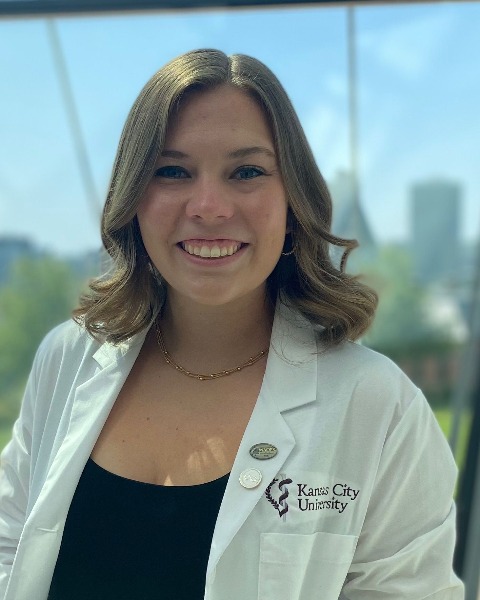Upper Limb Case & Anatomical Studies Posters
Poster: Upper Limb Case & Anatomical Studies Posters
64 - A Characterization of the Posterior Femoral Cutaneous Nerve and Its Clinical Application for Autologous Breast Reconstruction
Sunday, March 24, 2024
5:00pm - 7:00pm US EDT
Location: Sheraton Hall
Poster Board Number: 64
There are separate poster presentation times for odd and even posters.
Odd poster #s – first hour
Even poster #s – second hour
Co-authors:
There are separate poster presentation times for odd and even posters.
Odd poster #s – first hour
Even poster #s – second hour
Co-authors:
Charles Marchese - Kansas City University; Bethany Baumgartner - Kansas City University; Aaron Allard - Kansas City University; Bradley Creamer - Kansas City University; Jennifer Dennis - Kansas City University; Anthony Olinger - Kansas City University

Makayla M. Swancutt
Kansas City University
Kansas City, Missouri, United States
Presenting Author(s)
Abstract Body : Introduction and Objective: Autologous breast reconstruction (ABR) uses a harvested tissue flap from the abdomen, posterior thigh, or buttocks to rebuild the breast post-mastectomy. A common risk of ABR is loss of breast sensation. Identification of nerves for use in autologous sensate breast reconstruction flaps is an important surgical consideration. The posterior femoral cutaneous nerve (PFCN) and its branches supply sensory innervation to skin of the posterior thigh, leg, perineum, and buttocks, creating a feasible candidate for sensate profunda artery perforator (PAP) flaps for ABR and reestablishing breast sensation. This study characterized PFCN perforating branches located within the PAP flap region, as compared to an anatomical landmark intersection (ALI).
Materials and Methods: Twenty-three gluteal and posterior thigh regions from 15 formalin-embalmed donors were dissected to the level of the deep fascia to identify PFCN branches. PFCN branch diameter and length piercing the deep fascia were measured; branches were retro-dissected proximally to the PFCN trunk and the distance recorded. Captured images were analyzed to evaluate branch location in relation to the midline of the posterior thigh. Mean branch length and diameter, and mean distance to branch emergence were calculated.
Results: A mean of 3.26 branches were identified per PAP flap region with a mean diameter of mean 1.34 +/- 0.35 mm (range, 0.63 to 2.22 mm). The mean distance from ALI to the point of branch emergence from deep fascia was 113.55 ± 19.80 mm (range, 77.79 to 167.11 mm); mean branch length from deep fascia was 9.52 ± 7.83 mm (range, 2.40 to 52.31). The mean distance of branch emergence from midline of the posterior thigh was 18.90 +/- 11.17 mm (range, 1.68 to 47.54 mm); mean length of nerve branch to the main trunk of PFCN was 92.55 ± 38.00 mm (range, 8.50 to 174.61 mm). Two-Tailed T-tests comparing the left and right limb of eight donors determined bilateral, statistically significant differences between branch diameter (p = 0.019) and branch length out of deep fascia (p = 0.041); the length of nerve branches to the main trunk of PFCN was not significant (p=1.66).
Conclusion: These data characterize PFCN branching, however, no pattern in the location of the PFCN or its branches within the PAP flap region was identified. Statistically significant differences in the laterality of PFCN branch diameter and length were identified in a subset of donors.
Significance/Implication: These data illustrate the presence of PFCN branches and distinct differences in the laterality of PFCN branch diameter and length. Overall, this study highlights the importance of performing adequate nerve visualization studies bilaterally prior to surgical intervention as each patient presents with a unique PFCN branching pattern.
Materials and Methods: Twenty-three gluteal and posterior thigh regions from 15 formalin-embalmed donors were dissected to the level of the deep fascia to identify PFCN branches. PFCN branch diameter and length piercing the deep fascia were measured; branches were retro-dissected proximally to the PFCN trunk and the distance recorded. Captured images were analyzed to evaluate branch location in relation to the midline of the posterior thigh. Mean branch length and diameter, and mean distance to branch emergence were calculated.
Results: A mean of 3.26 branches were identified per PAP flap region with a mean diameter of mean 1.34 +/- 0.35 mm (range, 0.63 to 2.22 mm). The mean distance from ALI to the point of branch emergence from deep fascia was 113.55 ± 19.80 mm (range, 77.79 to 167.11 mm); mean branch length from deep fascia was 9.52 ± 7.83 mm (range, 2.40 to 52.31). The mean distance of branch emergence from midline of the posterior thigh was 18.90 +/- 11.17 mm (range, 1.68 to 47.54 mm); mean length of nerve branch to the main trunk of PFCN was 92.55 ± 38.00 mm (range, 8.50 to 174.61 mm). Two-Tailed T-tests comparing the left and right limb of eight donors determined bilateral, statistically significant differences between branch diameter (p = 0.019) and branch length out of deep fascia (p = 0.041); the length of nerve branches to the main trunk of PFCN was not significant (p=1.66).
Conclusion: These data characterize PFCN branching, however, no pattern in the location of the PFCN or its branches within the PAP flap region was identified. Statistically significant differences in the laterality of PFCN branch diameter and length were identified in a subset of donors.
Significance/Implication: These data illustrate the presence of PFCN branches and distinct differences in the laterality of PFCN branch diameter and length. Overall, this study highlights the importance of performing adequate nerve visualization studies bilaterally prior to surgical intervention as each patient presents with a unique PFCN branching pattern.

